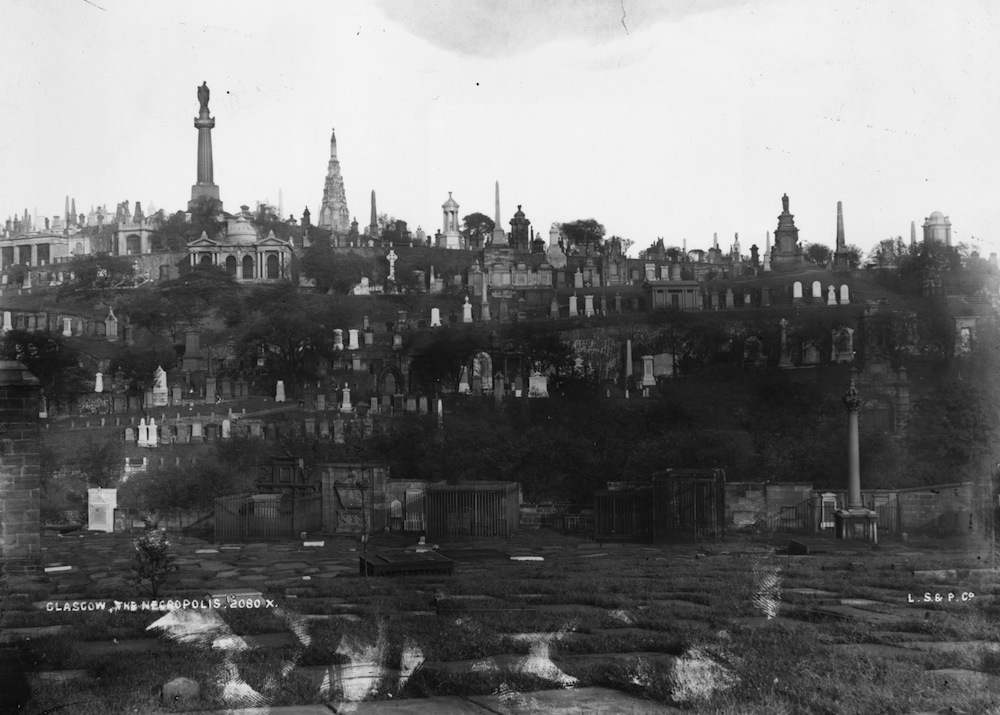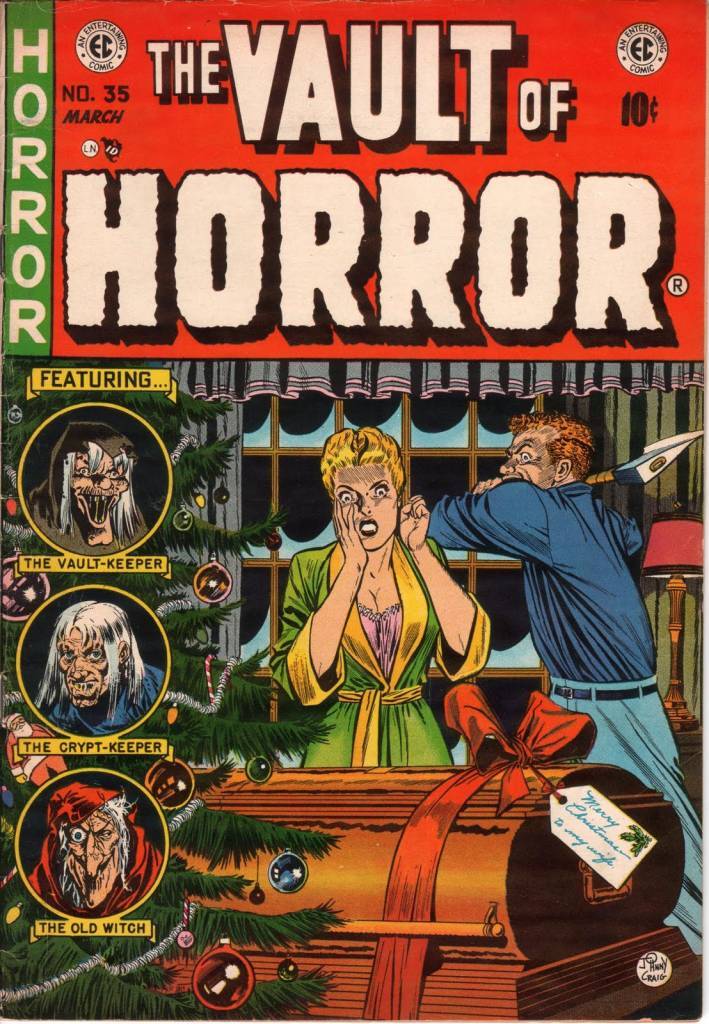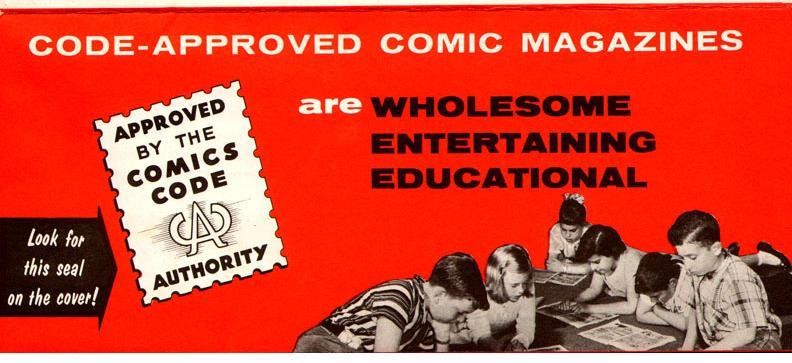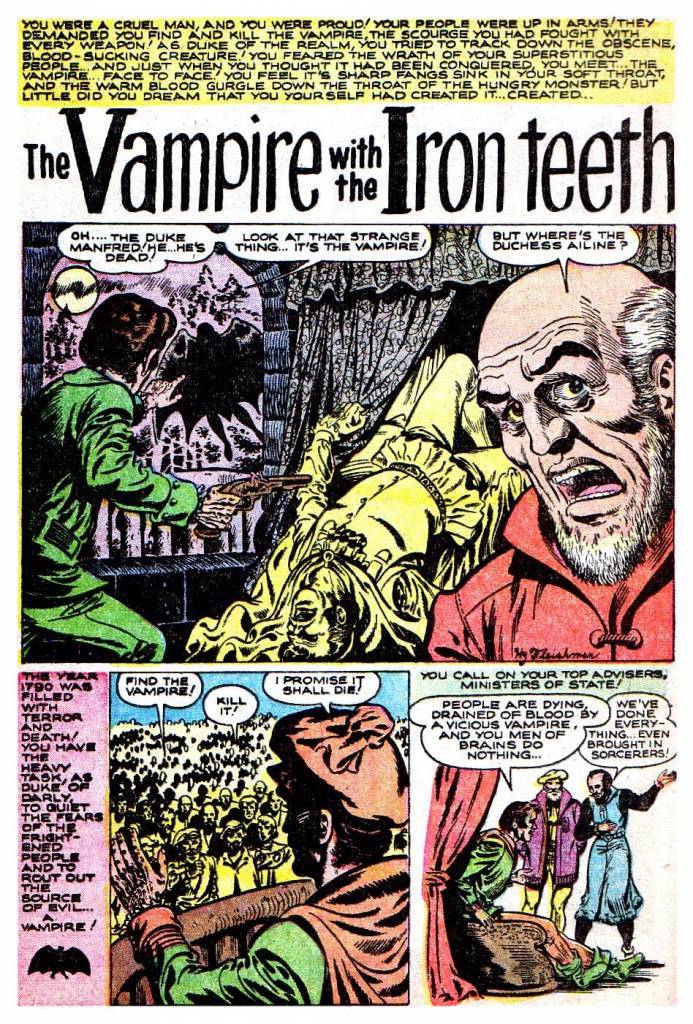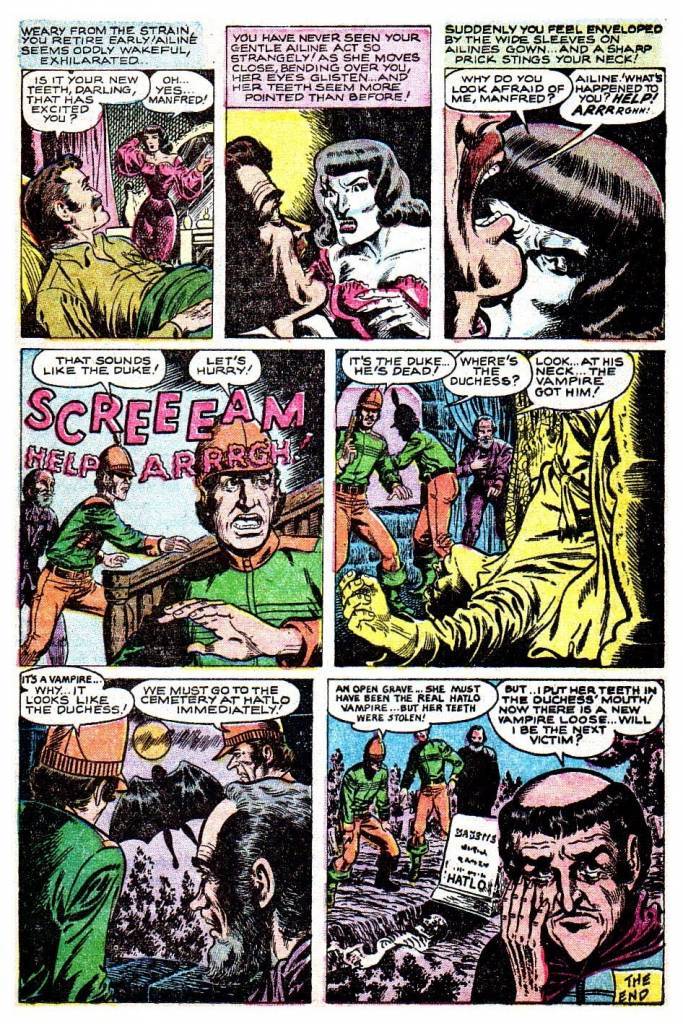On 23 September 1954, children aged 4 to 14 armed themselves with knives and stakes and marched on Glasgow’s sprawling Southern Necropolis graveyard. They had heard that two children had been eaten alive at the place known locally as ‘The City of the Dead’, where 250,000 bodies were buried. The only suspect was a 7-ft tall, iron-teethed vampire.
Ronnie Sanderson was aged 8 at the time.
“It all started in the playground – the word was there was a vampire and everyone was going to head out there after school. At three o’clock the school emptied and everyone made a beeline for it. We sat there for ages on the wall waiting and waiting. I wouldn’t go in because it was a bit scary for me. I think somebody saw someone wandering about and the cry went up: ‘There’s the vampire!’ That was it – that was the word to get off that wall quick and get away from it. I just remember scampering home to my mother: ‘What’s the matter with you?’ ‘I’ve seen a vampire!’ and I got a clout round the ear for my trouble. I didn’t really know what a vampire was.”
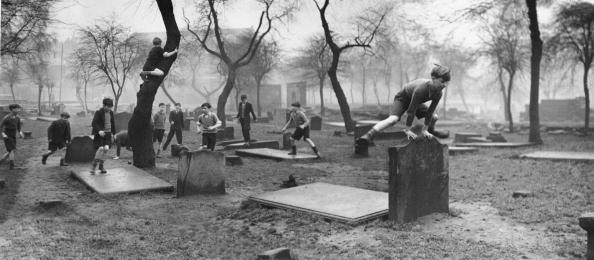
Kids laughed at death: Caption: A group of boys from the Gorbals play amongst the gravestones of the Corporation Burial Ground in Rutherglen Road, one of the few areas of greenery in the district. 1948.
No children had been reported missing. No-one had seen the monster. So, why had the story spread? And as it spread, the legend grew.
Tam Smith was 7 when horror stalked the land of the dead:
“There was an old lady who used to carry two cats in a basket. She would go to the graveyard to get peace away from the kids and let her cats have a wander. But she was in there the night we went looking for it and people were involving the ‘cat woman’ with the iron man. It was a shame when you think about it, she was an eccentric with wiry hair, but we called her Tin Lizzie. She was the iron man’s ‘burd’.”
The BBC recalls the guilty:
The blame for the vampire panic run-a-muck was laid on American horror comics, with the likes of Tales From The Crypt, The Haunt of Fear and The Vault of Horror becoming main targets.
The covers were fantastic.
So dangerous were these books that new laws were required to control them:
Word of the hunt only fuelled the war against horror comics in the US, which the newly created Comics Code Authority had already pegged as potentially dangerous to the well being of children everywhere. All three titles were canceled in 1954, with the last issue of the original run of Tales From the Crypt printed in February, 1955.
The Comics Code Authority would curtail this Seduction of the Innocent.
Comic books lived by these rules (via ComicArtville). Please excuse the reprint of the code in full, but so many parts of it are choice. It is all worth reading:
PREAMBLE
The comic book medium, having come of age on the American cultural scene, must measure up to its responsibilities.
Constantly improving techniques and higher standards go hand in hand with these responsibilities.
To make a positive contribution to contemporary life, the industry must seek new areas for developing sound, wholesome entertainment. The people responsible for writing, drawing, printing, publishing and selling comic books have done a commendable job in the past, and have been striving toward this goal.
Their record of progress and continuing improvement compares favorably with other media in the communications industry. An outstanding example is the development of comic books as a unique and effective tool for instruction and education. Comic books have also made their contributiuon in the field of letters and criticism of contemporary life.
In keeping with the American tradition, the members of this industry will and must continue to work together in the future.
In this same tradition, members of the industry must see to it that gains made in this medium are not lost and that violations of standards of good taste, which might tend toward corruption of the comic book as an instructive and wholesome form of entertainment, will be eliminated.
Therefore, the Comics Magazine Association of America, Inc. has adopted this Code, and placed strong powers of enforcement in the hands of an independent Code Authority.
Further, members of the Association have endorsed the purpose and spirit of this Code as a virtual instrument to the growth of the industry.
To this end, they have pledged themselves to conscientiously adhere to its principles and to abide by all decisions based on the Code made by the Administrator.
They are confident that this positive and forthright statement will provide an effective bulwark for the protection and enhancement of the American reading public, and that it will become a landmark in the history of self-regulation for the entire communications industry.
CODE FOR EDITORIAL MATTER
General Standards Part A
1. Crimes shall never be presented in such a way as to create sympathy for the criminal, to promote distrust of the forces of law and justice, or to inspire others with a desire to imitate criminals.
2. No comics shall explicitly present the unique details and methods of a crime.
3. Policemen, judges, government officials, and respected institutions shall never be presented in such a way as to create disrespect for established authority.
4. If crime is depicted it shall be as a sordid and unpleasant activity.
5. Criminals shall not be presented so as to be rendered glamorous or to occupy a position which creates the desire for emulation.
6. In every instance good shall triumph over evil and the criminal punished for his misdeeds.
7. Scenes of excessive violence shall be prohibited. Scenes of brutal torture, excessive and unnecessary knife and gun play, physical agony, gory and gruesome crime shall be eliminated.
8. No unique or unusual methods of concealing weapons shall be shown.
9. Instances of law enforcement officers dying as a result of a criminal’s activities should be discouraged.
10. The crime of kidnapping shall never be portrayed in any detail, nor shall any profit accrue to the abductor or kidnapper. The criminal or the kidnapper must be punished in every case.
11. The letter of the word “crime” on a comics magazine shall never be appreciably greater than the other words contained in the title. The word “crime” shall never appear alone on a cover.
12. Restraint in the use of the word “crime” in titles or sub-titles shall be exercised.
General Standards Part B
1. No comics magazine shall use the word horror or terror in its title.
2. All scenes of horror, excessive bloodshed, gory or gruesome crimes, depravity, lust, sadism, masochism shall not be permitted.
3. All lurid, unsavory, gruesome illustrations shall be eliminated.
4. Inclusion of stories dealing with evil shall be used or shall be published only where the intent is to illustrate a moral issue and in no case shall evil be presented alluringly nor as to injure the sensibilities of the reader.
5. Scenes dealing with, or instruments associated with walking dead, torture, vampires and vampirism, ghouls, cannibalism and werewolfism are prohibited.
General Standards Part C
All elements or techniques not specifically mentioned herein, but which are contrary to the spirit and intent of the Code, and are considered violations of good taste or decency, shall be prohibited.
Dialogue
1. Profanity, obscenity, smut, vulgarity, or words or symbols which have acquired undesirable meanings are forbidden.
2. Special precautions to avoid references to physical afflictions of deformities shall be taken.
3. Although slang and colloquialisms are acceptable, excessive use should be discouraged and wherever possible good grammar shall be employed.
Religion
1. Ridicule or attack on any religious or racial group is never permissible.
Costume
1. Nudity in any form is prohibited, as is indecent or undue exposure.
2. Suggestive and salacious illustration or suggestive posture is unacceptable.
3. All characters shall be depicted in dress reasonably acceptable to society.
4. Females shall be drawn realistically without exaggeration of any physical qualities. NOTE: It should be recognized that all prohibitions dealing with costume, dialogue, or artwork apply as specifically to the cover of a comic magazine as they do to the contents.
Marriage and Sex
1. Divorce shall not be treated humorously nor represented as desirable.
2. Illicit sex relations are neither to be hinted at or portrayed. Violent love scenes as well as sexual abnormalities are unacceptable.
3. Respect for parents, the moral code, and for honorable behavior shall be fostered. A sympathetic understanding of the problems of love is not a license for moral distortion.
4. The treatment of love-romance stories shall emphasize the value of the home and the sanctity of marriage.
5. Passion or romantic interest shall never be treated in such a way as to stimulate the lower and baser emotions.
6. Seduction and rape shall never be shown or suggested. 7. Sex perversion or any inference to same is strictly forbidden.
CODE FOR ADVERTISING MATTER
These regulations are applicable to all magazines published by members of the Comics magazine Association of America, Inc. Good taste shall be the guiding principle in the acceptance of advertising.
1. Liquor and tobacco advertising is not acceptable.
2. Advertising of sex or sex instruction books are unacceptable.
3. The sale of picture postcards, “pin-ups,” “art studies,” or any other reproduction of nude or semi-nude figures is prohibited.
4. Advertising for the sale of knives, concealable weapons, or realistic gun facsimiles is prohibited.
5. Advertising for the sale of fireworks is prohibited.
6. Advertising dealing with the sale of gambling equipment or printed matter dealing with gambling shall not be accepted.
7. Nudity with meretricious purpose and salacious postures shall not be permitted in the advertising of any product; clothed figures shall never be presented in such a way as to be offensive or contrary to good taste or morals.
8. To the best of his ability, each publisher shall ascertain that all statements made in advertisements conform to the fact and avoid misinterpretation.
9. Advertisement of medical, health, or toiletry products of questionable nature are to be rejected. Advertisements for medical, health or toiletry products endorsed by the American Medical Association, or the American Dental Association, shall be deemed acceptable if they conform with all other conditions of the Advertising Code.
(text source: Comics Magazine Association of America. Facts about Code-Approved Comics Magazines. New York: the Association, 1959.)
Joe Sergi looks at a few examples of how the code changed comics.
A great example is a story called “The Invasion,” which appeared as a pre-Code story in Witches’ Tales #21 and then again as a post-Code story in Race for the Moon #1. This story is a great example of the type of changes that Code imposed as it contains both major and minor revisions.
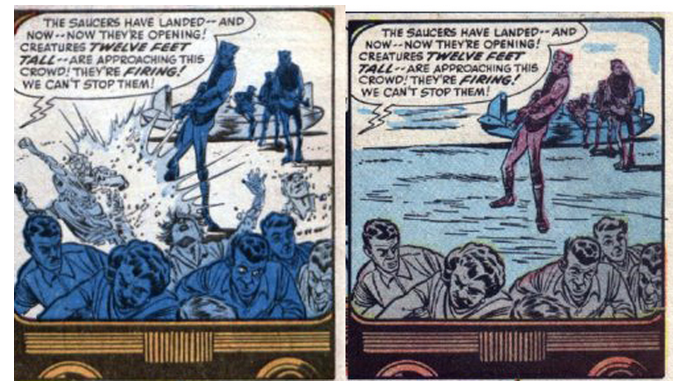
Take a look at a comparison of two scenes in the book with the post Code version on the right. Notice that the original text wasn’t changed. So now, without the additional art, the text doesn’t really make sense.
![[“The League of Handsome Devils” from Issue 2 of Fighting American] was published shortly before the Comics Code enveloped the U.S. comic book marketplace, dumbing things down and shoving the smaller publishers—like the one publishing Fighting American—off the newsstands and out of business. In 1966, Joe Simon and Harvey comics… put out a Fighting American reprint book…. It was issued under the Code and the censors required changes, which were made right on the on the original art. Of particular note is the first panel of the second page. An ice pick, clearly visible in the original printing, was surgically removed from the assailant’s hand and some of the text was altered.](https://flashbak.com/wp-content/uploads/2015/04/Screen-shot-2015-04-23-at-18.24.15.png)
[“The League of Handsome Devils” from Issue 2 of Fighting American] was published shortly before the Comics Code enveloped the U.S. comic book marketplace, dumbing things down and shoving the smaller publishers—like the one publishing Fighting American—off the newsstands and out of business.
In 1966, Joe Simon and Harvey comics… put out a Fighting American reprint book…. It was issued under the Code and the censors required changes, which were made right on the on the original art. Of particular note is the first panel of the second page. An ice pick, clearly visible in the original printing, was surgically removed from the assailant’s hand and some of the text was altered.
But about the Vampire with Iron Teeth…had it been in a comic?
Yes. Horropedia finds it:
So, it was the comics that had infected young minds.
Academics pointed out that none of the comics featured a vampire with iron teeth, though there was a monster with iron teeth in the bible (Daniel 7.7) and in a poem taught in local schools. Their voices were drowned out in a full-blown moral panic about the effect that terrifying comics were having on children. Soon the case of the “Gorbals Vampire” was international news.
The British Press raged against the “terrifying, corrupt,” comics and after a heated debate in the House of Commons where the case of Gorbals Vampire was cited.
One part of that incredible debate went like this:
Mr. John Rankin (Glasgow, Tradeston):
… I have in my possession copies of publications which were brought into this country by the American Forces….
The Bill deals with children and, in my view, it is preserving the right of the child to grow up without having its mind deprived of the freedom that it ought to have—the freedom from pollution. That is an important consideration.
These periodicals, of which I have an ample number here, are not merely horror comics. They do not deal merely with the horror aspect of life; they deal with something much more fundamental. They make a more damaging attack than that, because the young child is not greatly influenced by this horror aspect. I think that it shakes it off very quickly. These periodicals pollute the mind of the child.
They divide human society into two classes. First, there are the whites. One need only look at them to see the ladies, glamourous and half naked, and the men with all the physical attributes of the finest specimens in humanity. These are the whites. Of course, one cannot talk of every publication, and I am discussing the periodicals as a whole. The evil people are invariably those who are coloured.
In other words, these magazines identify evil with colour—either the colour of the skin or the colour of an idea. They imprison the mind of the young. They act as propagandist journals to spread an idea that all the good things, all the virtues, physical and mental, belong to one colour in the human society, and all the evil things are mated with those who are coloured differently from the race to which we belong.
That is a wrong thing to do. It is propaganda influencing the mind of the young along lines which every one of us deplores, as one knows from speeches which are made regularly in this House calling for the development of the underdeveloped parts of the world. We want to raise the standards of these people. We do not want to train our young to look 1149 upon them as necessarily associated in any way with evil ideas.
But these magazines go a stage beyond that, because wherever we have evil they show that it has to be hunted down. The type of justice that is vindicated is not the type of justice for which this House stands. It is not the type of justice that we believe in. It is summary justice, executed on the spot and often of the most brutal and sadistic nature. That is the evil in these journals. In that way they imprison the tender growing minds of the young. I hope that the Bill will be received with complete approval from both sides of the House, because it seeks to free the mind of our youth from these evil influences…
Last September a school in the Gorbals division of Glasgow closed for the day. By some system of bush telegraph, no one knows how, and as the children poured out of school, the word went round like wildfire that there was a vampire in a nearby cemetery; that this vampire had iron teeth and had eaten two young children. With that prattle, there went talk of space ships and men from Mars, and all the time there was talk about a monster. The “monster” had gripped the minds of the children, and so they armed themselves with sticks and stones and anything they could obtain, because they were out on a great mission—to destroy evil, to destroy the monster.
That is always a good thing, so we are told, although in Scotland, we must remember, there are good monsters and 1150 bad monsters. In the north of Scotland we have a loch called Loch Ness. It is inhabited by a monster, and anybody who said anything bad against the Loch Ness monster would find himself in great danger——
Mr. Deputy-Speaker (Sir Rhys Hopkin Morris):
I do not think that this Bill is directed against the Loch Ness monster.
Mr. Rankin:
That is the very point I am making. That is just what I am about to say, because our monster is a “verrey parfait gentil” creature indeed. She keeps out of the way all winter and only surfaces during the tourist season. She is a very thoughtful monster. Of course, the Loch Ness monster is a lady. We like her so much that we call her “Nessie” and no lady—not even the bearded lady—could ever be a really successful monster.
But we can see how the children from that school had their minds gripped by this idea, and how easily the idea spread and their impulses were directed to a particular end. The police found exceeding difficulty in controlling these children, which is an added reason why I hope that this Bill will receive unanimous support in the House, because its object is entirely worthy.
I believe that it is an attempt to free the minds of our children from evil influences. By this Bill we seek to keep their minds from being poisoned. Just as we would refuse to put poison on the breakfast table or the dinner table to be put into the bodies of our children, so I hope that tonight we shall refuse to instil poison into their minds.
Mr. Somerville Hastings (Barking):
A short time ago, a research was carried out in Glasgow with regard to delinquent children, and it was found that 44 per cent. of them had in their household or family people who had got into 1163 difficulty with the police. Other areas showed much the same, although perhaps not quite so high a proportion. I think that another objection to these horror comics is that they tend to blunt the finer feelings. They show that there is much brutality even when good overcomes evil.
I suggest that there is a third objection, which I do not think has been sufficiently stressed in the debate tonight. That is that these horror comics are terribly frightening to children. Children do not wear their hearts on their sleeves. One does not know what a child is thinking, but in young minds the pictures or incidents depicted often have a very profound effect. I remember that when I was a very small boy I was given a copy of “Pilgrim’s Progress.” I remember a picture in that copy until this day. It was a picture of Apollyon. I did not say anything to anyone about it, but I could not prevent myself from looking at it, and it frightened me very much. I do not think that this is good for children.
Britain duly passed the Children and Young Persons (Harmful Publications) Act 1955 which, for the first time, specifically banned the sale of magazines and comics portraying “incidents of a repulsive or horrible nature” to minors.
And all was calm once more in the land of dragons.
(In 1970s UK, a moral panic surrounded Action comic, which was duly banned.)
Would you like to support Flashbak?
Please consider making a donation to our site. We don't want to rely on ads to bring you the best of visual culture. You can also support us by signing up to our Mailing List. And you can also follow us on Facebook, Instagram and Twitter. For great art and culture delivered to your door, visit our shop.
